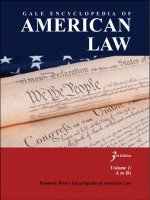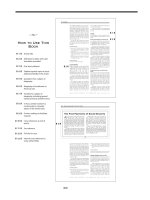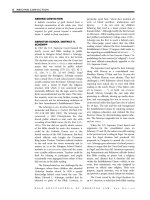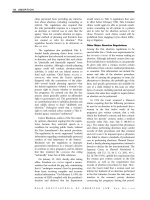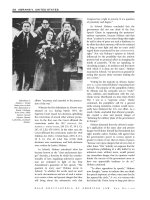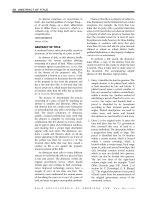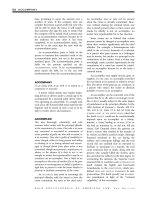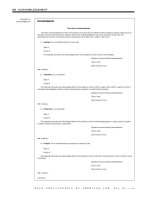Gale Encyclopedia Of American Law 3Rd Edition Volume 1 P55 pdf
Bạn đang xem bản rút gọn của tài liệu. Xem và tải ngay bản đầy đủ của tài liệu tại đây (448.92 KB, 10 trang )
into the control of MLB over the airwaves, the
federal appellate court ruled that the telecasts
were indeed copyrightable works and that clubs
were entitled to the revenues derived from
them.
As a result of these cases, economic
decisions regarding baseball have been left to
the players and owners. For this reason, baseball
has been seen as an anomaly with regard to U.S.
antitrust laws, and its exemption has been called
“an aberration confined to baseball” (Flood).
The push for congressional action to eliminate
this exemption intensified with the baseball
players’ strike from 1994 to 1995. The strike left
many in baseball, including fans , disenfran-
chised. Senator Howard M. Metzenbaum, an
Ohio Democrat who headed the subcommittee
on antitrust laws, led the fight to remove the
antitrust exemption from baseball. However,
the 234-day strike ended in an agreement
between owners and players, in which owners
promised to pay “luxury taxes” on clubs with
high payrolls. Congress was spared the necessity
of acting.
Local communities, however, faced the
possibility of losing their MLB franchises as
the economics of baseball changed dramatically
in the late 1990s. Major market teams, many of
them now owned by corporations rather than
wealthy individuals, drove up player payrolls.
This change hurt smaller market teams and
teams owned by individuals who either lacked
the resources or the desire to match salaries.
The Minnesota Twins, unable to secure a new,
publicly funded baseball stadium, threatened to
move to another state in 1997. The state of
Minnesota sought unsuccessfully to probe the
team’s finances and that of MLB, but in the end
the Twins could not secure a sale or move for
the team.
Unable to curb rising costs, the baseball
league proposed contracting two teams before
the 2002 season. Under contraction, MLB would
buy out the owners and distribute the players to
other teams through a draft. The league argued
that contraction would strengthen the financial
wellbeing of the sport. The owners, however,
needed to move quickly if contraction was to
happen before the 2002 season.
The Montreal Expos and the Minnesota
Twins were rumored to be the teams selected
for contraction. In Minnesota, the operators of
the Metrodome, where the Twins play their
home games, sued the Twins and MLB, asking a
state court to order the Twins to play the 200 2
season. They sought either to win on the merits
or delay contraction for a year. The judge issued
a
PRELIMINARY INJUNCTION and the Twins
appealed, arguing that the team did have an
obligation to pay the rent for the season, but
they could decide whether to play the season.
The Minnesota Court of Appeals, in Metropolitan
Sports Facilities Commission v. Minnesota Twins
Partnership, 638 N.W.2d 214 (2002), upheld the
injunction, which meant that contraction be-
came impossible for the 2002 season. The
baseball league later abandoned the concept of
contraction, at least fo r the near future.
In addition to its ongoing financial trou-
bles, baseball has faced other difficulties from
incidence of steroid abuse. Baseball first began
testing for performance-enhancing drugs dur-
ing the 2003 season. The testing was a type of
survey, designed to asses s the number of
players using steroids in the league. The te sts
were to be anonymous, and even those who
tested positive would not be punished. In
November 2003, MLB revealed that more than
5 percent of the tests conducted during the
2003 season were positive , prompting the first-
ever mandatory testing and punishment for
players who tested positive for performance-
enhancing drugs.
Donald Fehr of the
Major League Baseball
Players Association
addresses the findings
of the Mitchell Report,
which investigated
steroid use in baseball.
AP IMAGES
GALE ENCYCLOPEDIA OF AMERICAN LAW, 3RD E DITION
528 BASEBALL
In 2004 MLB faced increasing pressure from
government to strengthen its drug policy or face
legislative intervention. In 2005 MLB signifi-
cantly increased the pen alties for testing positive
for performance-enhancing drugs. The more
stringent standards required a 50-game suspen-
sion for the first offense, 100-game for the
second offense, and a lifetime ban from baseball
for the third offense.
In 2006 baseball commissioner Bud Selig
appointed former U.S. Senator George Mitchell
to investigate the use of performance-enhancing
drugs in major league baseball. Senator Mitchell’s
investigation culminated with the delivery of the
“Report to the Commissioner of Baseball of an
Independent Investigation into the Illegal Use
of Steroids and Other Performance Enhancing
Substances By Players in Major League Baseball,”
also known as the “Mitchell Report.” The Mitchell
Report, issued in 2007, found that the use of
performance-enhancing drugs had been perva-
sive for more than a decade, and it made
recommendations for MLB for the future. As of
2009, the legal ramifications of the steroid
investigation include government probes into
drug distribution and indictments against major
league players for
PERJURY and OBSTRUCTION OF
JUSTICE
, related to allegedly false denials of
steroid use.
FURTHER READINGS
Burk, Robert F. 1994. Never Just a Game. Chapel Hill: Univ.
of North Carolina Press.
Helyar, John. 1994. Lords of the Realm. New York: Villard
Books.
Kovaleff, Theodore P. 1994. The Antitrust Impulse. New
York: Sharpe.
Laitner, Colin. 2006. “Steroids and Drug Enhancements in
Sports: The Real Problem and the Real Solution.”De-
Paul Journal of Sports Law and Contemporary Problems.
3 (Summer).
Lewis, Michael. 2003. Moneyball: The Art of Winning an
Unfair Game. New York: Norton.
Manfred, Robert D., Jr. 2008. “Federal Labor Law Obstacles
to Achieving a Completely Independent Drug Program
in Major League Baseball.”Marquette Sports Law
Review. 19 (Fall).
Radomski, Kirk. 2009. Bases Loaded: The Inside Story of the
Steroid Era in Baseball by the Central Figure in the
Mitchell Report. New York: Hudson Street Press.
Sands, Jack, and Peter Gammons. 1993. Coming Apart at the
Seams. New York: Macmillan.
U.S. Congress Subcommittee on Economic and Commercial
Law. 1993–94. Baseball’s Antitrust Exemption: Hearing
before the Subcommittee on Economic and CommercialLaw.
Washington, D.C.: U.S. Government Printing Office.
U.S. Congress Subcommittee on Oversight and Govern-
ment. 2008. The Mitchell Report: The Illegal Use of
Steroids in Major League Baseball. Washington, D.C.:
U.S. Government Printing Office.
Zimbalist, Andrew S. 1992. Baseball and Billions: A Probing
Look Inside the Big Business of Our National Pastime.
New York: Basic Books.
Zimbalist, Andrew S., and Bob Costas. 2003. May the Best
Team Win: Baseball Economics and Public Policy.
Washington, D.C.: Brookings Institution.
CROSS REFERENCE
Sports Law.
BASIC BOOKS V. KINKO’ S
GRAPHICS CORP.
See COPYRIGHT “Copyright Law in Action”
(Sidebar).
BASIS
The minimum, fundamental constituents, foun-
dation, or support of a thing or a system without
which the thing or system would cease to exist. In
accounting, the value assigned to an asset that is
sold or transferred so that it can be determined
whether a gain or loss has resulted from the
transaction. The amoun t that property is estimat-
ed to be worth at the time it is purchased,
acquired, and received for tax purposes.
In a simple case, the basis of property for tax
purposes under the
INTERNAL REVENUE CODE is the
purchase price of a piece of property. For
example, if a taxpayer purchases a parcel of land
for $500,000, and no deductions apply to that
parcel of land, the taxpayer’s basis is $500,000.
If the taxpayer later sells the property for
$550,000, the amount of gain realized by the
transaction is the sale price ($550,000) less the
adjusted basis ($500,000), or $50,000.
Where a taxpayer is allowed to depreciate
property with a limited useful life, such as an
automobile used primarily for business pur-
poses, the taxpayer’s adjusted basis is reduced.
Assume a taxpayer purchases an automobile for
$30,000, and then claims deductions for $5,000.
The adjusted basis of the automobile is then
reduced to $25,000. When the taxpayer sells the
automobile for $26,000, the amount of gain
realized is $1,000 (the sale price of $26,000
minus the adjusted basis of $25,000).
FURTHER READINGS
Bankman, Joseph, et al. 2008 Federal Income Tax: Examples
and Explanations. 5th ed. Frederick, MD: Wolters
Kluwer Law & Business.
Hudson, David M., and Stephen A. Lind. 2007. Federal
Income Taxation. Eagan, MN: West.
GALE ENCYCLOPEDIA OF AMERICAN LAW, 3RD E DITION
BASIS 529
McEowen, Roger, and Neil Harl. 2008. Estate Planning,
PM–993. Available online at tate.
edu/basis.html; website home page: t.
iastate.edu (accessed August 28, 2009).
CROSS REFERENCES
Internal Revenue Code; Profit.
BASTARDY ACTION
An archaic name given to a court proceeding in
which the paternity of an illegitimate child is
determined in order to impose and enforce support
obligations upon the father.
The term bastardy action is derived from the
early common-law use of the word bastard to
describe a child born out of wedlock. Modern
legislation refers to such proceedings as filiation
proceedings or paternity suits because of the
derogatory connotation of the term bastard.
Although such proceedings are typically civil
actions, a few states have established such
actions as criminal proceedings.
CROSS REFERENCE
Illegitimacy.
v
BATES, DAISY LEE GATSON
Daisy Lee Gatson Bates, a CIVIL RIGHTS activist
and newspaper publisher, was a key figure in the
integration of public schools in Little Rock,
Arkansas, in the late 195 0s. When a storm of
violent public protest swept Little Rock, Bates
orchestrated the strategies that would reverse
200 years of state-sanctioned segregation.
Bates was born in 1920 in Huttig, in the
lumbering region of southeast Arkansas. When
she was a baby, her mother was raped and
murdered. No one was prosecuted for the
crime, but suspicion in the town centered on
three white men. After her mother’s death, her
father fled, leaving Bates with his best friends,
Orlee Smith and Susie Smith, who adopted her
and raised her as their only child. They were
kind and indulgent parents and Bates grew to be
a strong-willed and determin ed child. When she
was eight, she learned of the circumstances of
her birth and adoption. The painful knowledge
of her parents’ suffering and the harsh realities
of life in the rural south became driving forces
in Bates’s life.
Although she grew up during difficult
economic times, Bates’s childhood was relative-
ly comfortable. Her relatio nship with her
adoptive parents was warm and loving, and
she was especially close to her father. Neverthe-
less, Bates’s childhood was not easy. Like other
black children, she experienced the sting of
racial discrimination from an early age. She
attended a segregated public school, using worn
textbooks handed down from the white chil-
dren’s school. Her school was little more than a
room with a potbellied stove that gave so little
heat she and her classmates often kept their
coats on all day.
In 1941 Orlee Smith became gravely ill.
When he knew he was going to die, he called his
daughter to his side. He was aware of the anger
and pain she carried because of her mother’s
death and her father’s disappearance and because
of the bigotry that was a part of their everyday
life. He counseled her not to let hatred and
hostility control her but rather to use her strong
feelings as a catalyst to work for change. He said:
Don’t hate white people just because they’re
white. If you hate, make it count for
Daisy Lee Gatson Bates 1920–1999
▼▼
▼▼
19751975
1950195019251925
❖ ❖
◆◆◆◆
◆
◆◆◆◆
1920 Born
Huttig, Ark.
1954 Brown v. Board of Education
decided by U.S. Supreme Court
1952 Elected president of Arkansas State
Conference of NAACP branches
1939–45
World War II
1942 The Arkansas State
Press first published
1950–53
Korean War
1957 Little
Rock Nine
integrated
Central High
School
1959 State Press closed for financial reasons
1962 The Long Shadow of
Little Rock published
1971 Public school busing to
achieve integration began
1967 Elected to
NAACP national
board
1961–73
Vietnam War
1978 U.S. Supreme Court rejected racial
quotas in University of California v. Bakke
1986 The Long
Shadow of Little
Rock reprinted
1988 The Long Shadow of Little Rock
won American Book Award
19951995
◆◆
◆
1999 Died,
Little Rock,
Ark.
2001 Arkansas state law established
annual state holiday in memory of Bates
GALE ENCYCLOPEDIA OF AMERICAN LAW, 3RD E DITION
530 BASTARDY ACTION
something. Hate the humiliations we are
living under in the South. Hate the discrimi-
nation that eats away at the soul of every
black man and woman. Hate the insults
hurled at us by white scum—thentrytodo
something about it, or your hate won’t spell a
thing.
Smith’s death became a kind of rebirth for
Bates. She did not know it then, but his words
would strengthen and sustain her resolve during
the difficult struggles she was to face.
In 1942 Bates married Lucius Christopher
Bates, an insurance agent and friend of her late
father, and settled in Little Rock. Her husband
had majored in journalism at Wilberforce
College, in Ohio, and the young couple pooled
their savings and began publishing the Arkansas
State Press. While writing and publishing the
fledgling paper, Bates also enrolled in business
administration and public relations courses at
Shorter College, in Rome, Georgia. The State
Press quickly became the largest and most
influential black paper in Arkansas.
With the entry of the United States into
WORLD WAR II, Camp Robinson, near Little Rock,
was reopened. The influx of soldiers, many of
whom were black men from northern cities,
caused racial tensions to rise in the city. The
State Press had gained a reputation as an
independent “voice of the people” and regularly
attacked police brutality, segregation, and
inequities in the criminal justice system. When
the paper reported a particularly gruesome
incident in which a black soldier was killed by
a white policeman, many advertisers who were
wary of antagonizing their white patrons
withdrew their support, and circulation of the
paper dropped. However, the Bateses were able
to stay afloat and eventually regain their
advertisers and rebuild the paper’s circulation.
Their tenacity paid off in changes in working
and living conditions for blacks in Arkansas. For
example, as a result of their reporting on police
brutality in black neighborhoods, black police
officers were hired to patrol those areas.
From their earliest days in Little Rock, Bates
and her husband were active in the local branch
of the National Association for the Advance-
ment of Colored People (
NAACP). In 1952 Bates
was elected president of the Arkansas State
Conference of NAACP branches. In 1954 when
the Supreme Court handed down its historic
decision in
BROWN V. BOARD OF EDUCATION 347
U.S. 483, 74 S. Ct. 686, 98 L. Ed. 873 (1954),
declaring that segregated schools are “inhere ntly
unequal,” she and her colleagues began pressing
for implementation of the Court’s man date to
desegregate the schools “with all deliberate
speed” (Brown v. Board of Education, 349 U.S.
294 at 301, 75 S. Ct. 753 at 756, 99 L. Ed. 1083
[1955]). Because of her prominent position with
the NAACP, Bates found herself a central
character in the integration battle that soon
erupted in Little Rock.
The Little Rock School Board chose nine
black students to be the first to integrate Little
Rock Central High School. Planning and
coordination of the activities of the group,
which came to be known as the Little Rock
Nine, fell to Bates. By September 1, 1957, angry
crowds had begun milling around Central High
to protest and try to prevent the enrollment of
the black students. On September 2, the day
before school was to open, Governor Orval
Faubus dispatched the Arkansas
NATIONAL GUARD
and ordered it to surround Central. Claiming
that he was protecting Little Rock’s citizens
from possible mob violence, he declared that no
black students would be allowed to enter the
Daisy Bates.
AP IMAGES
GALE ENCYCLOPEDIA OF AMERICAN LAW, 3
RD E DITION
BATES, DAISY LEE GATSON 531
school and that “blood [would] run in the
streets” if any attempte d to do so.
NAACP lawyers Wiley Branton and
THUR-
GOOD MARSHALL
(later a U.S. Supreme Court
justice) promptly obtained an injunction against
Faubus for his interference, but Faubus refused
to withdraw the troops. Bates decided to have
the students enter the school in a group. She
contacted eight of them and told them to
assemble at a designated intersection the
morning of September 4 and travel to school
together. The ninth student, Elizabeth Eckford,
did not receive word of the plan. Unaware of
the maelstrom awaiting her, Eckford arrived at
Central High alone and was taunted, jeered, and
accosted by hundreds of white people as
reporters and photographers from around the
world observed and recorded the scene. The
National Guard did not attempt to help Eckford
but instead blocked her entrance to the school.
Neither she nor any of the other members of the
Little Rock Nine—who arrived later in a group,
as arranged—were allowed to pass through the
line of Guard members surrounding the school.
The attempt by Bates and the nine students
to enter Central set off a series of violent
incidents that continued for 17 days. On
September 20, attorneys Branton and Marshall
obtained an injunction barring the use of the
National Guard to interfere with integration at
Central High. By this time, the Bateses’ home
had become the unofficial center of activity and
communication for the integration effort.
Reporters from all over the United States came
and went, some staying days or weeks.
On September 23 all the Little Rock Nine
met at the Bates home to try again to exercise
their right to enter Central High. Traveling in
two cars they drove to a side entrance of the
building, away from the persistent throng, and
were escorted into the school by police officers.
Again mob violence spread through the city.
Later in the day the students were secretly
removed from the school through a delivery
entrance, and the chief of police declared that
Little Rock was under a reign of terror.
The next day the black students remained at
home. The mayor and the chief of police
appealed to the U.S.
DEPARTMENT OF JUSTICE for
assistance. In response, President
DWIGHT D.
EISENHOWER federalized the Arkansas National
Guard and ordered Secretary of Defense Charles
E. Wilson to enforce the integration order.
Wilson ordered 1,000 paratroopers from the
101st Airborne (“Screaming Eagles”) Division
of the 327th Infantry Regiment into Little Rock
to restore order.
On September 25 the Little Rock Nine
assembled again at the Bates home. Under the
protection of the paratroopers they were taken
to Central High, where they entered under the
watchful eyes of hundreds of reporters, photo-
graphers, and news camera operators. The
paratroopers remained at Central until Septem-
ber 30, when they withdrew to Camp Robinson,
12 miles away. The federalized Arkansas
National Guard remained on patrol at Central
until the end of the school year. Although it was
not necessary to recall the paratroopers, and the
number of minority students in Little Rock’s
formerly white schools steadily increased, vio-
lence, hatred, and acrimony continued to
plague the city for many years.
Bates endured many attempts to harass and
intimidate her, including rocks thrown through
her window, gunshots fired at her house,
dynamite exploded near her house, and crosses
burned on her lawn. In late October 1957 she
was arrested under a newly enacted ordinance
that required officials of organizations to supply
information regarding membership, donors,
amounts of contributions, and expenditures.
Although she was found guilty under the
ordinance, the conviction was later overturned
by the Supreme Court on grounds that the
ordinance requirement interfered with the
members’ freedom of association (Bates v. City
of Little Rock, 361 U.S. 516, 80 S. Ct. 412, 4 L.
Ed. 480 [1960]). In 1959 Bates and her husband
were forced to close the State Press for financial
reasons.
Through all the harassment Bates remained
determined to keep the wheels of the integra-
tion movement going forward. After closing the
newspaper she traveled throughout the United
States working on behalf of the Democratic
National Committee and the Johnson adminis-
tration’s antipoverty programs. In 1965 she
suffered a stroke and returned to Little Rock,
but she continued to be active in the NAACP
and in 1967 was elected to its national board. In
1968 she moved to Mitchellville, Arkansas, to
organize the Mitchellville Office of Economic
Opportunity Self-Help Project. The project was
responsible for new water and sewer systems,
paved streets, a community center, and a
swimming pool.
WE’VE GOT TO DECIDE
IF IT
’SGOINGTO
BE THIS GENERATION
OR NEVER
.
—DAISY BATES
GALE ENCYCLOPEDIA OF AMERICAN LAW, 3RD E DITION
532 BATES, DAISY LEE GATSON
In 1984 Bates revived the State Press and was
awarded honorary degrees by the University of
Arkansas and Washington University. In 1986
the University of Arkansas Press published a
reprint edition of her autobiography, The Long
Shadow of Little Rock, and in 1988 the book
received the American Book Award, the first
reprint edition to be given that honor.
In 1987 Bates sold the State Press but she
remained a consultant for the paper. In the
same year Little Rock named a new facility the
“Daisy Bates Elementary School”. Bates contin-
ued her involvement in community activities
until shortly before her death on November 4,
1999, in Little Rock. President
BILL CLINTON
honored her by allowing her body to lie in state
at the Capitol.
FURTHER READINGS
Bates, Daisy. 2007. The Long Shadow of Little Rock.
Fayetteville: Univ. of Arkansas Press.
Branch, Taylor. 1989. Parting the Waters: America in the
King Years, 1954–1963. New York: Simon & Schuster.
Hine, Darlene C., Elsa B. Brown, Rosalyn Terborg-Penn,
eds. 1993. Black Women in America: An Historical
Encyclopedia. Bloomington: Indiana Univ. Press.
Jacoway, Elizabeth, and C. Fred Williams, eds. 1999.
Understanding the Little Rock Crisis: An Exercise in
Remembrance and Reconciliation. Fayetteville: Univ. of
Arkansas.
Smith, Jessie C., ed. 2002. Notable Black American Women.
Detroit: Gale Research.
CROSS REFERENCES
Brown v. Board of Education of Topeka, Kansas; Civil Rights
Movement; NAACP; School Desegregation.
v
BATES, EDWARD
Edward Bates served as U.S. attorney general in
the cabinet of President
ABRAHAM LINCOLN from
1861 to 1864.
Bates was born September 4, 1793, in
Belmont, Virginia. He left his native Virginia
at the age of twenty-one and settled in Missouri,
where he concentrated his career efforts.
Bates was admitted to the Missouri bar in
1816 and was attorney general from 1820 to
1822. He was also a member of the Missouri
Constitutional Convention in 1820.
In 1822 Bates began the legislative phase of
his career as a member of the Missouri House of
Edward Bates 1793–1869
◆◆
◆
◆◆
❖
❖
1793 Born,
Belmont, Va.
1814 Moved to
Missouri Territory
1821 Missouri
statehood granted
1822 Elected to Missouri
House of Representatives
1821–26 Served
as U.S. district
attorney
1827–29
Served in U.S.
House of
Representatives
1830–34 Served as
member of
Missouri Senate
1834 Reelected
to Missouri
House of
Representatives
1850 Appointed
secretary of war
by President
Fillmore; declined
appointment
1861–64
Served as U.S.
attorney general
under Lincoln
1861–65
U.S. Civil War
1869 Died,
St. Louis, Mo.
▼▼
▼▼
1800
1790
1825
1850
1875
Edward Bates.
LIBRARY OF CONGRESS
LIBERTY CANNOT
EXIST EXCEPT UNDER
GOVERNMENT OF
LAW
.
—EDWARD BATES
GALE ENCYCLOPEDIA OF AMERICAN LAW, 3RD E DITION
BATES, EDWARD 533
Representatives. In 1827 he became a representa-
tive for Missouri in the U.S. House of Representa-
tives, serving for two years, and then returned to
state government as a member of the Missouri
Senate, serving from 1830 to 1834. In 1834 he
became a member of the Missouri House of
Representatives for a second time. Bates was also a
U.S.
DISTRICT ATTORNEY from 1821 to 1826.
Bates was an uns uccessful presidential
nominee at the Republican National Conven-
tion of 1860. He died March 25, 1869, in
St. Louis, Missouri.
BATTEL
Physical combat engaged in by an accuser and
accused to resolve their differences, usually
involving a serious crime or ownership of land.
It was recognized by the English king from the
eleventh to seventeenth centuries.
Trial by battel was introduced into England
by William the Conqueror. It was based upon
the belief that the winner of the battle, which
was tried by God, was the party who was in the
right in the dispute.
BATTERED CHILD/SPOUSE
SYNDROME
A condition created by sustained physical, sexual,
and/or emotional abuse, which creates a variety of
physical and emotional symptoms.
Violence of any kind is traumatic to victims,
and the thought that someone could exert
extreme violence against a loved one or a child
is repulsive. Battered-child syndrome and
battered-spouse syndrome are both the result
of repeated violence—beatings, choking, sexual
ASSAULT, verbal abuse, or any co mbination. The
resulting trauma leaves its victims with physical
and emotional scars, which can show up in a
variety of symptoms that can come on gradually
or suddenly. Often the symptoms are similar to
other, less dangerous conditions. Sometimes
there are no visible symptoms. From a legal
perspective, this makes both syndromes difficult
to prove. The fact that there is heated disagree-
ment about these syndromes, what they repre-
sent, and in fact whether they are true
syndromes at all, only adds to the difficulty.
Although both syndromes stem from the same
violent behavior (and in some cases, the same
perpetrator), they need to be treated separately.
Battered-Child Syndrome
Children can be subjected to violence at the
hands of any adult with whom they have
contact. It could be a parent, an older sibling,
a babysitter, a day-care provider, a family friend,
a parent’s romantic partner—in short, anyone.
Some children are victimized by several people.
The victimization can come in the form of
physical violence,
SEXUAL ABUSE, or verbal abuse.
If one of these factors is present, chances are
that others are present as well. Physical abuse
can go undetected for a long time. A child who
suffers repeated falls or broken bones might be
considered “clumsy”, or the injuries might be
brushed off as the kind of bumps and bruises all
children get. Sexual abuse might have no
outward signs, or the victim might be unusually
forward or inappropriately flirtatious with
adults.
Even infants are not immune to abuse. In
shaken-baby syndrome, a baby is shaken so
violently that brain injury can occur; repeated
shaking episodes or even just one particularly
severe episode can result in death.
A child suffering from battered child
syndrome might be quiet and withdrawn,
lethargic, depressed, or violent. Someone who
does not kno w the particular child might not
immediately spot emotional symptoms, but if
the child displays unchildlike behavior, coupled
with unexplained chronic physical bruising,
chances are the child is a victim of abuse.
Those who investigate child-abuse crimes
must be extremely thorough, especially if the
child is very young and thus unable to
corroborate what the evidence shows. Some-
times a ph ysician will spot signs of abuse or
battered-child syndrome when a child is
brought into an emergency room for treatment
of some injury. A full investigation requires
interviews with anyone who has access to the
child, including parents, siblings, other relativ es,
neighbors, day-care providers or babysitters,
teachers, and doctors. Even those who are not
involved in abuse might have valuable informa-
tion to provide. Often, those who have
committed the abuse will offer vague or
conflicting information about what led to a
particular injury. If warranted, a child could be
placed in temporary
PROTECTIVE CUSTODY while
an investigation proceeds. Depending on the
extent and severity of abuse, those who have
committed the abuse might benefit from
GALE ENCYCLOPEDIA OF AMERICAN LAW, 3RD E DITION
534 BATTEL
counseling or other forms of treatmen t (e.g.,
substance or they might face criminal charges
and serve a prison sentence.
Battered-Spouse Syndrome
Battered-spouse syndrome is more commonly
called “ battered-women’s syndrome” because
most of the victims are women, either wives or
girlfriends of the perpetrators. However, abused
husbands and boyfriends have gained increased
attention, as have same-sex abuse by gay and
lesbian partners. With
CHILD ABUSE, investigators
are often at a loss because the child is too young
to testify. In cases of battered-spouse syndrome,
however, the problem is that often the victim
refuses to testify. Guilt and shame are primary
reasons, particularly for men who expect they
will be ridiculed for being abused by a woman.
Fear is an even stronger factor in abuse victims’
silence.
Typical symptoms of a battered-spouse
syndrome victim include the openly physical
ones—bruises, black eyes, broken bones, cuts
and scratches. The emotional symptoms include
depression, lack of self-esteem, and hopeless-
ness. Sufferers might be “hypervigilant” to any
signs of conflict on the part of the spouse.
Denial that a problem exists is a common
response to questions from concerned friends,
loved ones, or even medical professionals.
The phrase “battered-women’s syndrome”
was first used in the early 1980s; in ensuing
years lawyers began using the “battered woman”
defense in
HOMICIDE cases in which women
killed their husbands or boyfriends. Many
women claimed
SELF-DEFENSE, explaining that
the
MURDER victim had been physically abusive
for years. As the concept of battered-spouse
syndrome became more clearly articulated in
the 1980s and 1990s, the syndrome as a self-
defense argument gained strength. In fact, it
played into the
CLEMENCY decisions of several
governors, beginning with Governor Richard
Celeste of Ohio, who in 1990 granted clemency
to 25 women who had murdered their spouses.
Their trials had been unfair, he concluded,
because testimony about their abuse had not
been allowed as evidence. Other governors
followed suit in the ensuing years, including
Maryland govern or Donald Schaefer, Massa-
chusetts governor William Weld, and California
governors Pete Wilson and Gray Davis. Experts
in
DOMESTIC VIOLENCE explained to skeptics the
reason why many battered women did not
simply leave their husbands, either to stay with
friends or go to a women’s shelter. In some
cases, they said, these women had been so
emotionally broken that they were too fright-
ened to leave. Some had been abused for so long
that they had actually come to believe that they
were responsible for their own abuse.
In the 1990s a new movement emerged to
point out that abuse can happen to men as well
as women. The number of abused men was
estimated at no higher than five percent of the
abuse cases, and to a large extent it was not
taken seriously. Advocacy groups for women
claimed that for a man to claim that his wife or
girlfriend physically terrorized him were absurd.
Law enforcement officials often took abuse
charges less seriously when the complainant
was a man. Since the late twentieth century,
statistical evidence about male abuse has been
gaining credibility. Moreover, gay and lesbian
partner abuse has also begun to be taken more
seriously. In 1999 a Brooklyn, N.Y., Supreme
Court judge ruled that a gay man who had
stabbed his partner to death could invoke
battered-spouse syndrome at his trial.
The bottom line from a legal standpoint is
that battered-spouse syndrome, like battered-
child syndrome, requires solid and substantive
evidence if it is to be used as a defense in a
murder trial. A woman who has no visible
physical signs of abuse might have been abused,
but simply claiming to have been abused with
no evidence at all at least warrants a thorough
investigation. Cases in which women—and
men—have claimed that an estranged spouse
has been violent, simply to gain custody of their
children, are not uncommon. The issue of
battered spouses may be clearer in the first years
of the twenty-first century than it was in the
1970s and 1980s, but it continues to evolve.
FURTHER READINGS
Justice Department Web site. 2002. Battered Child Syndrome:
Investigating Physical Abuse and Homicide. Washington,
D.C.: U.S. Department of Justice. Available online at
web-
site home page: (accessed July 6,
2009).
Parrish, Rob. 2009. Abused Men: The Hidden Side of
Domestic Violence. Westport, CT: Greenwood.
Walker, Lenore E. 2009. The Battered Woman Syndrome. 3d
ed. New York: Springer.
CROSS REFERENCES
Domestic Violence; Child Abuse; Women’ sRights.
GALE ENCYCLOPEDIA OF AMERICAN LAW, 3RD E DITION
BATTERED CHILD/SPOUSE SYNDROME 535
BATTERY
At common law, an intentional unpermitted act
causing harmful or offensive contact with the
“person” of another.
Battery is concerned with the right to have
one’s body left alone by others.
Both a tort and a crime, its essential element,
harmful or offensive contact, is the same in both
areas of the law. The main distinction between the
two categories lies in the penalty imposed. A
DEFENDANT sued for a tort is civilly liable to the
PLAINTIFF for damages. The punishment for crimi-
nal battery is a fine, imprisonment, or both.
Usually battery is prosecuted as a crime only in
cases involving serious harm to the victim.
Elements
The following elements must be proven to
establish a case for battery: (1) an act by a
defendant; (2) an intent to cause harmful or
offensive contact on the part of the defendant; and
(3) harmful or offensive contact to the plaintiff.
The Ac t The act must result in one of two
forms of contact. Causing any physical harm or
injury to the victim—such as a cut, a burn, or a
bullet wound—could constitute battery, but
actual injury is not required. Even though there
is no apparent bruise following harmful contact,
the defend ant can still be guilty of battery;
occurrence of a physical illness subsequent to
the contact may also be
ACTIONABLE. The second
type of contact that may constitute battery
causes no actual physical harm but is, instead,
offensive or insulting to the victim. Examples
include spitting in someone ’s face or offensively
touching someone against his or her will.
Touching the person of someone is defined as
including not only contacts with the body, but also
with anything closely connected w ith the body,
such as clothing or an item carried in the person’s
hand. F or e xample , a battery may be committed
by intentionally knocking a hat off someone’s
head or knocking a glass out of someone’shand.
Intent Although the contact must be intended,
there is no require ment that t he defendant int end
to harm or injure the victim. In
TORT L AW,theintent
must be either specific intent—the contact wa s
specifically intended—or gene ral intent—the de-
fendantwassubstantiallycertainthattheactwould
cause the contact. T he i nt ent e lement is satisfied in
CRIMINAL LAW when the act is done with an intent to
injure or with criminal negligence—failure to use
care to avoid criminal consequences. The intent for
criminal law is also present when the defendant’s
conduct is unlawful even though it does not
amount to
CRIMINAL NEGLIGENCE.
Intent is not negated if the aim of the contact
was a joke. As with all torts, however, consent is
a defense. Under certain circumstan ces consent
to a battery is assumed. A person who walks in a
crowded area impliedly consents to a degree of
contact that is inevitable and reasonable. Con-
sent may also be assumed if the parties had a
prior relationship unless the victim gave the
defendant a previous warning.
There is no requirement that the plaintiff be
aware of a battery at the time it is committed.
The gist of the action is the lack of consent to
contact. It is no defense that the victim was
sleeping or unconscious at the time.
Harmful or Offensive Conduct It is not
necessary for the defend ant’s wrongful act to result
in direct contact with the victim. It is sufficient if
the act sets in motion a force that results in the
contact. A defendant wh o whipped a ho r se o n
which a plaintiff was riding, c ausing the plaintiff to
fall and be injured, was found guilty of battery.
Provided all other elements of th e offense are
present, the offense ma y also be comm itted by
causing the victim to harm himself. A defendant
who fails to act when he or s he has a duty to do so is
guilty—as where a nurse fails to warn a blind
patientthatheisheadedtowardanopenwindow,
causing him to fall and injure himself.
Aggravated Battery
When a battery is committed with intent to do
serious harm or
MURDER,orwhenitisdonewith
a dangerous weapon, it is described as aggravated.
A weapon is considered dangerous whenever the
purpose for using it is to cause death or serious
harm. State statutes define aggravated battery in
various ways—such as
ASSAULT with intent to kill.
Under such statutes, assault means both battery
and assault. It is punishable as a felony in all states.
Punishment
In a CIVIL ACTION for tortious battery, the penalty is
damages. A jury determines the amount to be
awarded, which in most cases is based on the harm
done to the plaintiff. Even though a plaintiff
suffers no actual injury,
NOMINAL DAMAGES (a small
sum) may still be awarded on the theory that there
has been an invasion of a right. Also, a court may
award
PUNITIVE DAMAGES aimed at punishing the
defendant for the wrongful act.
GALE ENCYCLOPEDIA OF AMERICAN LAW, 3RD E DITION
536 BATTERY
Criminal battery is punishable by a fine,
imprisonment, or both. If it is considered
aggravated the penalties are greater.
v
BAYLOR, ROBERT EMMETT
BLEDSOE
Robert Emmett Bledsoe Baylor achieved prom-
inence as a jurist, a Baptist preacher, and a law
professor. He was instrumental in the founding
of the first Baptist college in Texas, which was
named Baylor University in his honor.
Baylor was born May 10, 1793, in Lincoln
County, Kentucky. He began his political career
in 1819 with service in the Kentucky legislature,
moving to the Alabama legislature in 1824. He
represented Alabama in the U.S. House of
Representatives from 1829 to 1831.
In 1839 Baylor settled in Texas and began a
judicial career. He was appointed to a Texas
district court in 1841 and also served as associate
judge of the Supreme Court of the Republic of
Texas from 1841 to 1845. Following the annex-
ation of Texas by the United States, he rendered
decisions as a U.S. district judge from 1845 to
1861. He was also instrumental in the formation
of the Texas state constitution in 1845.
As a Baptist preacher, Baylor helped to
procure a charter for a Baptist college that
would come to be named Baylor University.
The university was originally located in Inde-
pendence, Texas, but later moved to Waco in
1886, where it remained. Baylor began teaching
courses in the science of law at the new
university in 1849. In 1857, Baylor University
established its original school of law, and Baylor
served on the original faculty. With the excep-
tion of the period of the
CIVIL WAR, when the
school of law did not offer classes, Baylor taught
courses in
CONSTITUTIONAL LAW and jurispru-
dence until 1873. He died on December 30,
1873, in Washington County, Texas.
FURTHER READINGS
“1849 to 1883: The Early History.” Baylor Law School.
Available online at />Time_Periods/early.htm; website home page: http://
law.baylor.edu (accessed July 6, 2009).
Baylor, Robert Emmett Bledsoe (1793–1874). In Biographical
Directory of the United States Congress 1774–Present.
Available online at />biodisplay.pl?index=B000257; website home page: http://
bioguide.congress.gov (accessed August 28, 2009).
McSwain, Betty Ann McCartney. 1976. The Bench and Bar of
Waco and McLennan County, 1849–1976. Waco, TX:
Texian.
Robert Emmett Bledsoe Baylor 1793–1873
◆◆◆◆
❖
❖
1775–83
American Revolution
1793 Born,
Lincoln
County, Ky.
1824 Elected to
Alabama legislature
1819 Elected to
Kentucky legislature
1829–31
Represented
Alabama in the
U.S. House of
Representatives
1839
Moved
to Texas
1841–45 Served as associate justice
of the Texas Supreme Court
1845 Founded the first Baptist college
in Texas, now called Baylor University
1845–61 Served as
U.S. district judge
1873 Died,
Washington
County, Tex.
1861–65 U.S.
Civil War
▼▼
▼▼
17751775
18251825
18501850
18751875
18001800
GALE ENCYCLOPEDIA OF AMERICAN LAW, 3RD E DITION
BAYLOR, ROBERT EMMETT BLEDSOE 537

